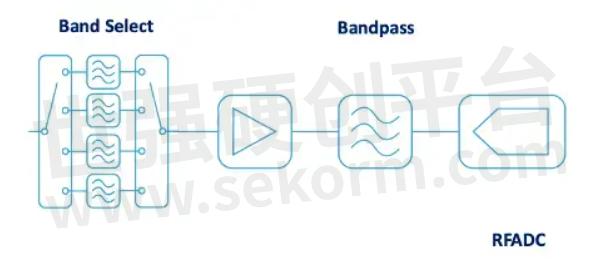The Role of Filters in Expanding Bandwidth for Electronic Warfare Receivers




Electronic warfare (EW) systems are an increasingly critical component of modern warfare. They seek to control and exploit the electromagnetic spectrum to gain an advantage over adversaries while preventing them from reciprocating. This includes detecting and denying the use of radar systems and GPS. There are three main sectors within electronic warfare. Electronic attack (EA) focuses on acts designed to disrupt, degrade, destroy or deceive. Electronic protection (EP) seeks to diminish the effectiveness of adversarial EA systems. Electronic support (ES) extracts signal information for intelligence purposes.

From a design perspective, addressing the complexity of EW missions presents broad technical challenges. To meet strict size, weight and power requirements, engineers are miniaturizing and integrating functions like signal acquisition, processing and generation into complex components. In tandem, there are efforts to develop broader bandwidth sensors and rapid sensor switching capabilities to process and analyze a wider range of frequencies and adapt in real time.
To achieve this expanded level of functionality, it’s advantageous to digitize signals earlier in the receive chain to allow the system to adapt. In software-defined radio (SDR), signal processing relies on software rather than hardware, adding the versatility needed for real-time function. While SDR isn’t new, engineers are applying it to a wider range of frequencies as RF analog-to-digital converters (RF-ADCs) advance.
Since RF-ADCs are capable of sampling at higher rates, EW receiver tuners can select larger portions of the spectrum. While this is a major advancement, there are tradeoffs to consider. As SDRs operate across more frequencies and in digital, they become more susceptible to intentional and unintentional interference (i.e., jamming).
This shift also indicates that, while there may less of a need for analog components, RF filters are still advantageous in some cases. The fundamental role of a filter is changing with technology choice and availability, and the industry needs a range of frequency bands in filters to best support these cases. As we shift from IF conversion to RF conversion, filters can focus on other essential functions like band select and anti-alias to maximize bandwidth and out of band rejection.
For example, a modern tuner, shown in Figure 1, can take advantage of an RF-ADC to sample RF directly, resulting in a simpler receiver design. A band select function, like a switched filter bank, selects the relevant region of spectrum followed by a single bandpass filter, which can perform anti-aliasing for the ADC.

Figure 1: Modern wideband tuner design
An anti-alias bandpass filter is required when a digital receiver makes use of under-sampling. This is a technique where an ADC is used capture information contained in frequency bands that are at center frequencies higher than the Nyquist rate (i.e. half of the sampling rate of the ADC). This is possible up to the analog bandwidth of the ADC. For example, in Figure 2 our band of interest (shown in green) is above 0.5fs and sits in the second Nyquist zone. There will be images (show in yellow) located in the Nyquist zones above and below.

Figure 2: Anti-aliasing filter for undersampling
A bandpass filter is chosen to select the band of interest. Where the filter slope meets the red dashed line in Figure 2, noise from the images above and below will be aliased into the passband, allowing noise into the receiver, and setting a limit on the dynamic range.
A higher rejection filter would have a steeper slope, meeting the adjacent images further down the y-axis and increasing the dynamic range. Conversely, a steeper slope on a wider band filter would allow us to widen the green band of interest. The yellow images will widen also, but the increased performance filter allows us to fit within the narrowed transition band, keeping the same dynamic range as before.
Bandpass filter selection in this kind of application aims to make maximum use of the available bandwidth (up to 0.5fs) while keeping a high dynamic range. Wideband, high rejection filters are ideal in this situation, and having very wideband filters that can match the very high sampling rates of modern RFADCs is an enabler in digital receiver design.
- |
- +1 赞 0
- 收藏
- 评论 0
本文由星晴123转载自Knowles Official Website,原文标题为:The Role of Filters in Expanding Bandwidth for Electronic Warfare Receivers,本站所有转载文章系出于传递更多信息之目的,且明确注明来源,不希望被转载的媒体或个人可与我们联系,我们将立即进行删除处理。
相关推荐
Knowles(楼氏电子)射频滤波器(定制产品)选型指南
目录- Company Profile Technology Capabilities Ceramic Technology Package Option Ceramic Resonators Cavity Filters Lumped Element Filters Bandpass Filters Bandreject Filters Lowpass and Highpass Dual Bands / Multi-Bands & Diplexers Multiplexers Specialty Filters Space Heritage
型号- 942274,943440,943441,943442,943443,918565,936908,940694,943480,932199,938738,936754,930257,941699,938533,935061,938576,938571,935265,934450,935264,935384,935263,942225,931406,940121,933827,936669,932342,936741,935535,935579,943503,943504,941008,942658,943627,936740,938044,942330,942331,942651,943501,943502,935838,938949,939606,936735,940989,932413,937501,938556,DR03F36Q1550AYB,933984,938635,908704,937144,936333,923787,943452,942320,942080,930615,931396,940417,937017,938663,931190,938660
Knowles‘ Microstrip Filters Offer a High Repeatability and Temperature Stability from -55℃ to 125℃
Since Knowles acquired Integrated Microwave Corporation (IMC) in 2020, Knowles has an extended its range of RF and microwave filtering solutions to include a wide variety of ceramic coaxial resonators, lumped element filters, and cavity filters from the VHF to the Ka-band.
B350NB2S 35.0GHz表面贴装带通滤波器
描述- 该资料介绍了Knowles Precision Devices公司生产的35.0GHz表面贴装带通滤波器B350NB2S。该滤波器采用低损耗、温度稳定的材料,具有小型化、温度稳定性好等特点,适用于多种频率范围,提供高度可重复的性能。
型号- B350NB2S,B350NB2S-T
B052NC5S 5.20GHz表面贴装带通滤波器
描述- 该资料介绍了Knowles Precision Devices公司生产的5.20GHz表面贴装带通滤波器B052NC5S。该滤波器采用低损耗温度稳定材料制造,具有小型化、全屏蔽组件和良好的温度稳定性等特点。它适用于多种频率范围,提供高度可重复的性能。
型号- B052NC5S,B052NC5S-T
918565陶瓷带通滤波器数据表
描述- 本资料为Knowles生产的陶瓷带通滤波器(P/N: 918565)的数据表。该滤波器具有表面贴装特性,适用于2450 MHz中心频率,具备良好的插入损耗、反射系数和抑制比等性能指标。
型号- 918565
B289KA0S 28.9GHz表面贴装带通滤波器
描述- 该资料介绍了Knowles Precision Devices公司生产的28.9GHz表面贴装带通滤波器B289KA0S。该滤波器采用低损耗、温度稳定的材料,具有小型化设计,性能随温度变化小,适用于多种频率带,提供高度可重复的性能。
型号- B289KA0S,B289KA0S-T
B280MF1S 28GHz N257 5G表面贴装带通滤波器
描述- 该资料介绍了Knowles公司生产的28GHz n257 5G表面贴装带通滤波器(型号B280MF1S)。这款滤波器适用于5G频段,采用低损耗温度稳定材料制造,具有小型化设计和高频率稳定性。特性包括小尺寸、屏蔽、表面安装、湿度敏感度等级MSL1以及宽工作存储温度范围。
型号- B280MF1S-T,B280MF1S
B096QC2S 9.6GHz表面贴装带通滤波器
描述- 该资料介绍了Knowles Precision Devices公司的一款9.6GHz表面贴装带通滤波器(型号B096QC2S)。这款滤波器采用低损耗温度稳定材料制造,具有小型化、全屏蔽组件和良好的温度稳定性。其规格涵盖了插入损耗、反射损耗、边带抑制等重要参数,适用于多种频率范围。
型号- B096QC2S,B096QC2S-T
B192NB2S 19.2GHz表面贴装带通滤波器
描述- 该资料介绍了Knowles Precision Devices公司生产的19.2GHz表面贴装带通滤波器B192NB2S。该滤波器采用低损耗温度稳定材料制造,具有小型化设计和高重复性性能。其主要特性包括小尺寸、全屏蔽组件、焊盘表面安装包装、MSL1级防潮等级、频率稳定性以及宽工作温度范围(-55°C至+125°C)。此外,还提供了插入损耗、反射损耗、边带抑制比等电气规格。
型号- B192NB2S-T,B192NB2S
B424MEZS 42.5 GHz表面贴装带通滤波器
描述- 本资料介绍了Knowles公司的一款42.5 GHz表面贴装带通滤波器(型号B424MEZS),适用于5G频段。该滤波器采用低损耗温度稳定材料,具有小型化设计,频率稳定性高,并提供了多种频率选项。
型号- B424MEZS
B084MC6S 8.42GHz表面贴装带通滤波器
描述- 该资料介绍了Knowles Precision Devices公司生产的8.42GHz表面贴装带通滤波器B084MC6S。该滤波器采用低损耗、温度稳定的材料,具有小型化设计,性能随温度变化小,适用于多种频率带,提供高度可重复的性能。
型号- B084MC6S,B084MC6S-T
B148QF0S 14.8GHz表面贴装带通滤波器
描述- 该资料介绍了Knowles Precision Devices公司生产的14.8GHz表面贴装带通滤波器B148QF0S。该滤波器采用低损耗温度稳定的材料制造,具有小型化设计、全屏蔽组件、焊接表面安装包封等特点。其频率稳定性好,工作与存储温度范围宽,适用于多种电子设备。
型号- B148QF0S,B148QF0S-T
B145RE0S 14.5GHz表面贴装带通滤波器
描述- 该资料介绍了Knowles Precision Devices公司的一款14.5GHz表面贴装带通滤波器B145RE0S。这款滤波器采用低损耗温度稳定材料,具有小型化、全屏蔽组件和良好的温度稳定性等特点。它适用于多种频率范围,提供高度可重复的性能。
型号- B145RE0S,B145RE0S-T
B021MC8S 2.105 GHz表面贴装带通滤波器
描述- 本资料介绍了Knowles Precision Devices公司的一款2.105 GHz表面贴装带通滤波器(B021MC8S)。该滤波器采用低损耗温度稳定材料,具有小型化设计,并在不同温度下保持稳定的性能。它提供多种频率选择,适用于各种应用。
型号- B021MC8S-T,B021MC8S
B040RG9S 4.0GHz表面贴装带通滤波器
描述- 该资料介绍了Knowles Precision Devices公司生产的4.0GHz表面贴装带通滤波器B040RG9S。该滤波器采用低损耗、温度稳定的材料,具有小型化设计,性能稳定,适用于多种频率范围。
型号- B040RG9S,B040RG9S-T
电子商城
现货市场





























































































































































































登录 | 立即注册
提交评论